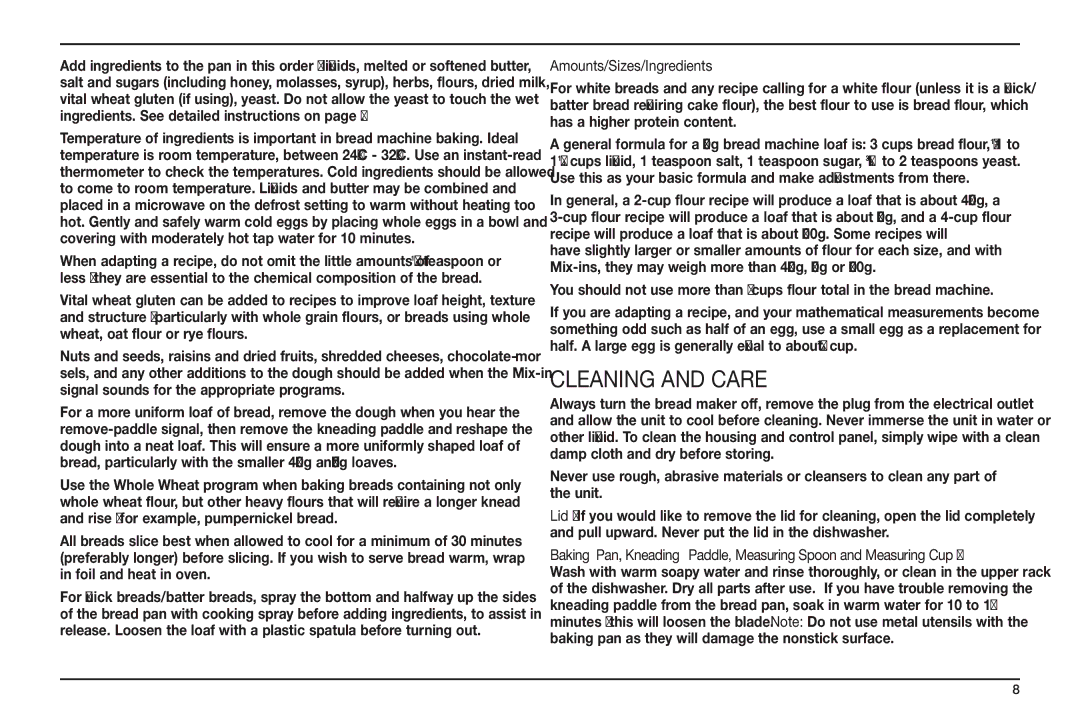
Add ingredients to the pan in this order – liquids, melted or softened butter, salt and sugars (including honey, molasses, syrup), herbs, flours, dried milk, vital wheat gluten (if using), yeast. Do not allow the yeast to touch the wet ingredients. See detailed instructions on page 7.
Temperature of ingredients is important in bread machine baking. Ideal temperature is room temperature, between 24°C - 32°C. Use an
When adapting a recipe, do not omit the little amounts of 1⁄2 teaspoon or less – they are essential to the chemical composition of the bread.
Vital wheat gluten can be added to recipes to improve loaf height, texture and structure – particularly with whole grain flours, or breads using whole wheat, oat flour or rye flours.
Nuts and seeds, raisins and dried fruits, shredded cheeses, chocolate mor- sels, and any other additions to the dough should be added when the
For a more uniform loaf of bread, remove the dough when you hear the
Use the Whole Wheat program when baking breads containing not only whole wheat flour, but other heavy flours that will require a longer knead and rise – for example, pumpernickel bread.
All breads slice best when allowed to cool for a minimum of 30 minutes (preferably longer) before slicing. If you wish to serve bread warm, wrap in foil and heat in oven.
For quick breads/batter breads, spray the bottom and halfway up the sides of the bread pan with cooking spray before adding ingredients, to assist in release. Loosen the loaf with a plastic spatula before turning out.
Amounts/Sizes/Ingredients
For white breads and any recipe calling for a white flour (unless it is a quick/ batter bread requiring cake flour), the best flour to use is bread flour, which has a higher protein content.
A general formula for a 680g bread machine loaf is: 3 cups bread flour, 11⁄8 to 11⁄4 cups liquid, 1 teaspoon salt, 1 teaspoon sugar, 13⁄4 to 2 teaspoons yeast. Use this as your basic formula and make adjustments from there.
In general, a
have slightly larger or smaller amounts of flour for each size, and with
You should not use more than 5 cups flour total in the bread machine.
If you are adapting a recipe, and your mathematical measurements become something odd such as half of an egg, use a small egg as a replacement for half. A large egg is generally equal to about 1⁄4 cup.
CLEANING AND CARE
Always turn the bread maker off, remove the plug from the electrical outlet and allow the unit to cool before cleaning. Never immerse the unit in water or other liquid. To clean the housing and control panel, simply wipe with a clean damp cloth and dry before storing.
Never use rough, abrasive materials or cleansers to clean any part of the unit.
Lid – If you would like to remove the lid for cleaning, open the lid completely and pull upward. Never put the lid in the dishwasher.
Baking Pan, Kneading Paddle, Measuring Spoon and Measuring Cup – Wash with warm soapy water and rinse thoroughly, or clean in the upper rack of the dishwasher. Dry all parts after use. If you have trouble removing the kneading paddle from the bread pan, soak in warm water for 10 to 15 minutes – this will loosen the blade. Note: Do not use metal utensils with the baking pan as they will damage the nonstick surface.
8
